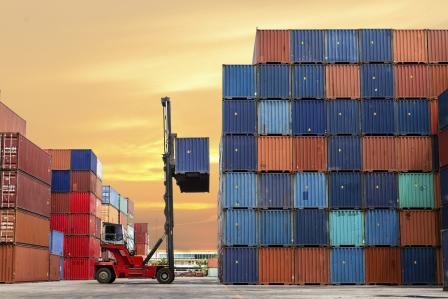SmartWay Program: Promoting Supply Chain Sustainability at Ports
Overview
EPA’s SmartWay program helps thousands of companies across the United States and Canada – from global corporations to medium and small businesses - advance supply chain sustainability by measuring, benchmarking, and improving their environmental footprint and the efficiency of goods movement. Ports are a critical link in the transportation supply chains of these companies. Many of the shippers (also known as Beneficial Cargo Owners or BCO’s), logistics companies, and carriers that join SmartWay use and share best practices, innovative strategies and technologies that help to move goods more cleanly and efficiently through ports. Some of the strategies that SmartWay partners use include:
Freight Consolidation
HP, Inc. merged Less-Than-Truckload (LTL) and low-density truck shipments from ocean ports into full truckload intermodal shipments, reducing CO2 emissions by 13,000 tonnes. HP, Inc. is also moving to alternative fueled vehicles, is moving as much cargo to rail as possible, and is reducing distances to their distribution centers.
-
Merging less-than-truckload and low-density shipments into full truckload intermodal container shipments headed to and from ports;
-
Employing better container weight and volume management to reduce the number of containers needed; and
-
Improving product design to minimize shipping weight and/or volume, so more goods can be moved in each shipment.
-
Using less packaging to fit more product into each container, thus reducing overall number of containers, and truck or rail delivery miles in and around ports. One example is to use plastic slip sheets instead of pallets which are larger and heavier, and often constructed of wood or composite material.
Optimized Freight Networks and Information Technology
Kimberly-Clark Corporation is locating distribution centers and freight transfer facilities in markets that reduce port truck dray mileage and/or reduce truck turn times at ports.
- Locating freight infrastructure and vehicle routing to reduce drayage vehicle miles travelled and exposure of populations to truck exhaust;
- Improving forecast planning, satellite tracking and container identification for ease of access and location resulting in more efficient management and tracking of container freight;
- Improving and harmonizing port terminal information portal systems to better manage pickups and deliveries at ports, which reduces unnecessary truck queuing and idling time.
Greater Use of Rail
White Arrow LLC is locating their warehouses and distribution centers as close to rail terminals as possible to decrease annual miles travelled.
-
Constructing distribution, production, and manufacturing centers with rail access that link to port on-dock rail facilities, and eliminate unnecessary port dray truck miles between port and rail terminals; and
-
Scheduling production/delivery dates to enable greater use of rail, which eliminates unnecessary truck movements in and around ports.
More Efficient Chassis Pool Management
- Promoting better preventative maintenance practices through shipper ownership of truck chassis, so shipments aren’t delayed by chassis breakdowns, thereby reducing unnecessary empty truck miles and congestion at ports; and
-
Using ports and terminals that employ “chassis pools” which reduces the number of empty truck and cargo handling miles in a port area. There are two primary types of chassis pools:
-
Neutral Pools, in which chassis are owned by third-parties and rented out; and
-
Cooperative (Co-op) Pools, in which chassis are owned by a collection of steamship lines or terminals.
-
Electrification of Refrigerated Units
- Opting to ship temperature-controlled goods in trailers and intermodal containers equipped with electric plug-in refrigeration units allows the use of local electricity to power the refrigeration rather than diesel engines attached to the units. Pollution from electricity generation is usually less than diesel engines.
 Trucking and Port Efficiency
Trucking and Port Efficiency
- Offering more flexible appointment windows for truck pickup and delivery of port-bound cargo, to allow the carrier to better time its arrival at the port, which reduces unnecessary idling or queuing at the port; and
-
Unloading, stacking and organizing containers by shipper from large shippers to promote free-flow container operations. Truckers simply take the next available container from the stack, instead of possibly having port container moving equipment sift through multiple containers. This reduces pollution and saves energy by requiring fewer moves per container. This process works in reverse as well, allowing drivers to pick up empty containers at the distribution centers and return them to the port.
More SmartWay Information
Explore the SmartWay Transportation Partnership links below to find information on how companies can track and improve performance.
- Learn more about the SmartWay Program
- Learn how the SmartWay Partnership works
- Learn about SmartWay Verified Technologies
- Sign-up for SmartWay E-Updates
- View a full listing of SmartWay partners

